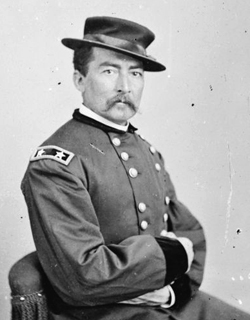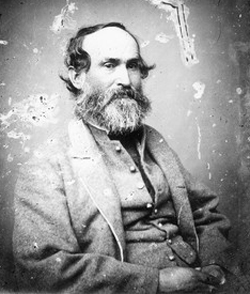Cedar Creek • Tour the Battlefield • Battle Maps • The Armies
The Battle of Cedar Creek was fought on October 19, 1864. It was the last of three major battles in thirty days for control of the Shenandoah Valley and the last major battle in the Shenandoah Valley of the Civil War.

Sheridan’s Ride by Thure de Thulstrup, 1886
Today much of the battlefield is private land, but a partnership of organizations is working to preserve important parts of the field and interpret them for future generations. Four monuments and a series of markers tell a small part of one of the most important battles of the Civil War.
On this site
Tour the Cedar Creek battlefield and see its monuments, buildings, views and historical markers.
Battle Maps show the positions of the forces through the course of the day’s fighting.
The Armies shows the organization of both armies that fought here, with links for many of the units to unit histories on our companion website, Civil War in the East.
Surprise Attack
From start to finish the Battle of Cedar Creek was one of the most dramatic battles of the war. Confederate Lieutenant General Jubal Early launched it with a risky night march that led to a daring pre-dawn attack against heavy odds in dense fog. His assault crushed the Union flank and center and sent the better part of the Union Army stampeding to the rear in disorder. With the odds reversed, the Union survivors fell back while fighting a desperate rear guard action. By late morning the fighting died down of sheer exhaustion. Many of the starving, barefoot Confederates dropped out of the ranks to pillage the well-supplied Union camps.
Stunning Reversal
At this point Union Major General Philip Sheridan burst on the scene. He had been absent from the battle in the morning, returning from a conference in Washington, and heard the murmur of artillery fifteen miles away in Winchester. Mounting his big black horse, Rienzi, he rode to the sound of the guns, rallying fugitives along the way with promises that “We’ll make coffee of Cedar Creek tonight!” When he reached the battlefield the veterans of the Sixth Corps and Cavalry were still ready for a fight, and wildly cheered him.
For the next five hours Sheridan filled up his line with rallied men and prepared. At 4 p.m. he launched an attack with five infantry divisions that ground into the Confederate defenders for close to an hour. As the Confederate flank started to unravel Sheridan unleashed his powerful cavalry divisions on each flank. The Confederate line dissolved as the men, for the third time in a month, raced the Union cavalry for safety. It was the end of Early’s Army of the Valley and the Confederate threat from the Shenandoah that had haunted Washington since the beginning of the war.
Where was the Battle of Cedar Creek?
The Battle of Cedar Creek was fought in the Shenandoah Valley around the village of Middletown, Virginia. Middletown is 12 miles south of Winchester, Virginia, 67 miles west of Washington, D.C., and 112 miles northwest of Richmond, Virginia.
Who fought in the Battle of Cedar Creek?
The Battle of Cedar Creek was fought beween the Confederate Army of the Valley under Lieutenant General Jubal Early and the Union Army of the Shenandoah, at first under the temporary command of Major General Horatio Wright but later in the day under Major General Philip Sheridan, who returned mid-morning from a meeting in Washington.
How many men fought in it?
Early commanded around 21,000 Confederates. Union forces numbered around 32,000 men.
 Major General Philip Sheridan |
 Lieutenant General Jubal A. Early |
How many casualties were there?
There were about 5,700 Union casualties and 2,900 Confederate casualties. It ranked behind the Third Battle of Winchester as the second bloodiest battle in the Shenandoah Valley.
Why was the battle fought?
Robert E. Lee sent Jubal Early to the Shenandoah Valley in June, as Grant’s armies forced him into a defensive battle around Richmond and Petersburg. Early’s mission was to try to recreate the brilliant success of ‘Stonewall’ Jackson’s Shenandoah Valley campaign of 1862, which diverted Union troops away from McClellan’s attack on Richmond in much larger numbers than Jackson’s force.
Early succeeded, causing Grant to keep three Union infantry corps and two cavalry divisions in the Valley. But by October Early’s force had been worn down to the point where Sheridan was considering returning some of his men to Grant at Petersburg. Badly outnumbered, Early gambled that an audacious surprise attack could disrupt Union plans and keep Sheridan’s men in the Valley.
Who won the Battle of Cedar Creek?
The North. Early came very close, capturing 24 Union guns and over twelve hundred prisoners and driving most of the Union army off the field in confuson. Had the battle ended at 10 a.m. it would have been a decisive Confederate victory.
But the Confederate attack stalled by midday and the Union Sixth Corps and cavalry stubbornly remained on the field and unbeaten. This gave Sheridan time to arrive from Winchester, rally his men, and launch a devastating counterattack that crushed the Confederate army.
What were the results?
Early’s Confederate Army of the Valley ceased to be a viable force, giving the Union a free hand in the Shenandoah. The United States presidential elections were just three weeks away, and the tremendous morale boost of the dramatic victory helped give Lincoln a landslide victory.
But even while losing his army as a fighting force Early succeeded in one of his goals. Just before the battle the Union Sixth Corps had been preparing to return to the Petersburg front but the battle convinced Sheridan to delay until December, by which time winter weather had shut down campaigning for the year. Sheridan’s cavalry did not return until March. The delay to Union forces returning to the Siege of Petersburg probably bought Lee – and the Confederacy – an extra couple of months of time.
It’s impossible to say how all this might have been different if Early had repeated Jackson’s feat of 1862 and had driven Sheridan’s army in disorder into the defenses of Harpers Ferry – something that Early was obviously trying for. It’s clear that the results would have been out of proportion to the small force that Early was hazarding – and that his gamble was worth the throw.
